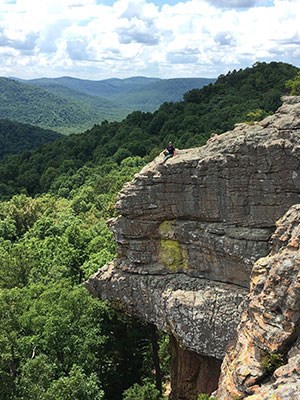Part of a series of articles titled Park Paleontology News - Vol. 10, No. 2, Fall 2018.
Article
Uncovering the Fossil Record of Buffalo National River

Article by Aliera Konett, GIP Paleontology Intern, Buffalo National River
for Park Paleontology Newsletter, Fall 2018
In its enabling legislation, Buffalo National River was created in order to conserve the natural resources along the river, and educate present and future visitors about them. One of the main interpretive goals of the park includes helping to tell historic and prehistoric stories about the river. I have had the privilege of being part of the first attempt to undertake a comprehensive fossil inventory of Buffalo National River.
Almost every stratigraphic unit here in the Buffalo National River is brimming with Paleozoic (541 to 252 million years ago) fossils, including crinoids, brachiopods, bryozoans, and occasionally trilobites. The national river is one of those incredible places where it is common to find limestone strata which consists of approximately 90% crinoids. Crinoids have colloquially been called “lilies of the sea,” and I personally enjoy thinking about how the sea floor during this time must have looked like wildflower fields full of crinoids, as far as the eye can see. And like the field of wildflowers, there is a wide variety in the type of crinoids that have been found here, which includes an unusual barrel-shaped crinoid. The remains of these organisms look like little beads or old barrels.
The bedrock of Buffalo National River includes outcrops of nearly twenty different rock formations, all from the Paleozoic Era (541 to 252 million years ago), and primarily deposited under shallow marine conditions. The oldest rocks go all the way back to the Ordovician period (485 to 444 million years ago), and this was also where my studies started. I was surprised to find a great abundance of stromatolites, fossil algal mats consisting of layers of sediment and cyanobacteria, in parts of the Everton Formation. Skolithos is an invertebrate trace fossils, representing backfilled vertical worm burrows, present in some of the Ordovician formations, most notably in the St. Peters Sandstone.

NPS Photo
Silurian (444 to 419 million years ago) rocks are present within the park’s exposures and contrain exceptionally well preserved fossils. Perfectly preserved nautiloids grace the bluffs of the Buffalo River, varying in size from just a few inches long to the length of a forearm. These remain are imbedded within a few stretches of river and are visible from the river.

NPS Photo

NPS Photo
Devonian (419 to 359 million years ago) age rocks are not present along the Buffalo National River. Uplift and erosion in the area has completely erased the time period. However, it is very likely that the shallow marine depositional environment persisted into the Devonian.
The Mississippian (359 to 323 million years ago) and Pennsylvanian (323 to 299 million years ago) is represented by sedimentary deposits in shallow seas, with transgressive and regressive (sea level rise and fall, respectively) sequencing. Fossils at Buffalo National River from these time periods reflect organisms who thrived in these ancient shallow seas.
A continental collision near the end of the Paleozoic changed the landscape dramatically as the mountains were uplifted and folded. Extensive erosion of the area occurred during the Mesozoic Era (252 to 66 million years ago) eroding away any geologic strata deposited during the entirety of this period. The limestone and chert deposited during the Mississippian have begun to weather and dissolve, creating caves, fissures, sinkholes and other karst features in the limestone formations.

NPS Photo
During the Pleistocene ice ages a diversity of ancient mammals inhabited Arkansas. Fossil evidence of these mammals are preserved in the sinkholes and caves in and around Buffalo National River. Bears, giant armadillos, peccaries, and many other ice age animals have been found in the karst features in and around the park, including body fossils and trace fossils. These come in the forms of bear den hollows, claw swipes, hoof marks, slides, scrapes and rubs within these caves. These animals existed in the Buffalo River region as recently as 20,000 years ago.
One of the most significant fossil localities present near the park is the Conard Fissure. Excavated in 1908 by paleontologist Barnum Brown, the Conard Fissure produced no fewer than fifteen different specimens of saber-tooth cats, several other big cats, bears, peccaries, giant armadillos, and hundreds of pounds of other bone material. Most of these fossils are now housed at the American Museum of Natural History in New York City. Two successive excavations were also performed here in order to remove as much fossiliferous material as possible from the Fissure. One follow-up dig was conducted by Brown and another was conducted by James Quinn, who excavated the nearby Peccary Cave as well. There is a chance that this incredible piece of Arkansas’ history will be acquired by the National Park Service, and become a resource for research and interpretation within Buffalo National River. This story, both historic and prehistoric, shows how beautifully intertwined the past and the present are here in the Buffalo National River.
Related Links
- Buffalo National River, Arkansas—[Geodiversity Atlas] [Park Home]
- NPS—Fossils and Paleontology
- NPS—Caves and Karst
- National Fossil Day Partnership
- NPS—Geology
Last updated: July 8, 2020
